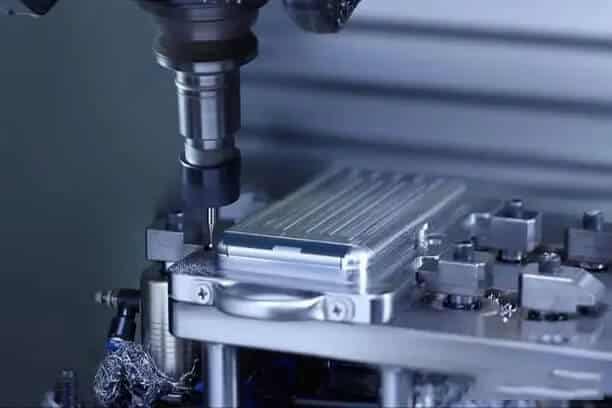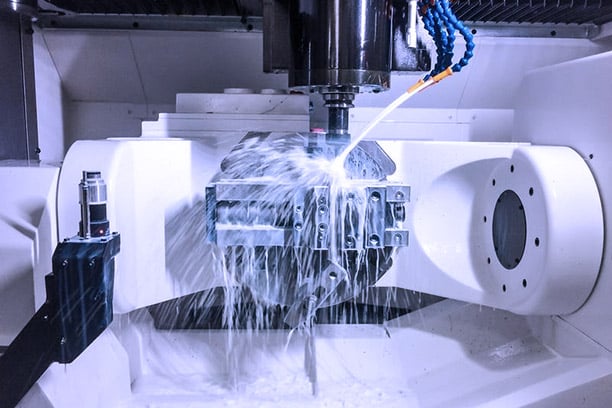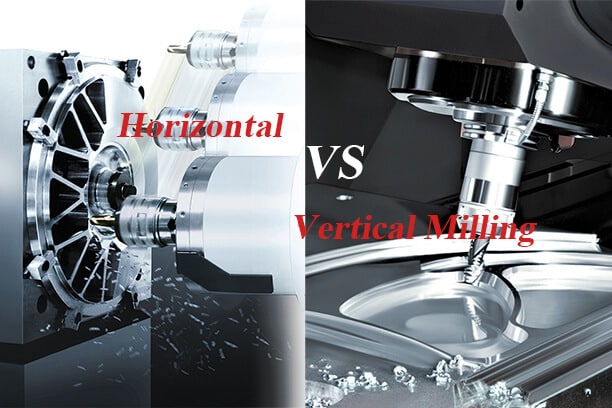In today’s age of automation, 4-axis CNC machining has become a key player in different manufacturing methods. This technique offers four different movement options, allowing it to carry out several tasks at once. It’s also useful for handling more parts simultaneously. Therefore, manufacturers often choose 4-axis CNC machining as a cost-effective way to boost their production capacity.
How does 4-axis CNC machining operate? What sets it apart from 3-axis and 5-axis CNC machining? What are the benefits and drawbacks of each type?
To discover more, read the full article.
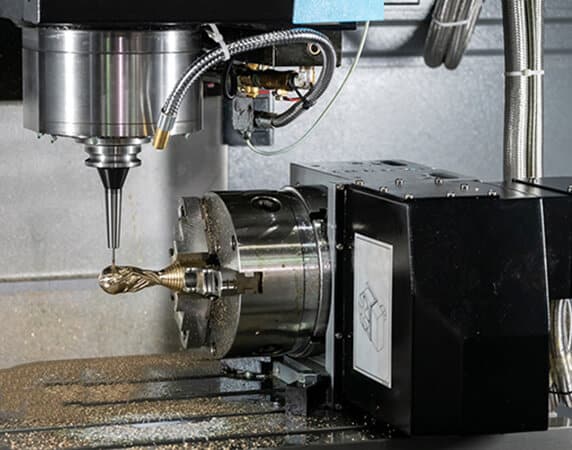
What is 4-axis CNC Machining?
4-axis CNC machining is a type of advanced machining that uses CNC machines with an extra rotating axis. This rotation lets you work on four sides of a part while it remains clamped in one position, requiring only a single setup. This feature enables the creation of intricate parts and the ability to mill at unusual angles, which 3-axis machining can’t do.
4-axis machines come in different styles, but they are commonly found in the ‘vertical machining‘ format. In this setup, the spindle moves around the Z-axis. We’ll focus on vertical 4-axis milling here.
This method involves the usual three axes – X, Y, and Z – like in 3-axis machining, plus an additional A-axis, which rotates around the X-axis. The workpiece is fixed along the X-axis and can rotate with its fixture on the A-axis.
4-axis machining is particularly useful for making cut-outs and holes on the sides of a part or cylindrical surfaces. Using 4-axis machining instead of 3-axis often saves time by reducing the need for multiple setups. It also helps in maintaining precise dimensions on all four sides of a part since it’s held in one setup.
More complex shapes, such as arcs and helices, are more efficiently produced with 4-and 5-axis machining. This approach also makes cutting angled features simpler. However, when using the 4th axis, these angled features must be aligned on the same axis. If the angles vary, the setup (and possibly the fixture) may need to be adjusted for each different angle.
Categories of 4-axis CNC Machines
4-axis machining is done on various types of machining centers. While they all feature four axes, their design and operation differ.
Based on their operating mechanism, these machines can be classified into two main categories :
- Positional (3+1 Axis)
- Simultaneous (True 4 Axis)
1. Positional (3+1 Axis)
A Positional 4-axis machine is essentially a 3-axis CNC machine with an added feature. It includes a fourth axis that allows the workpiece to rotate along the X-axis. However, it can’t perform simultaneous machining on multiple surfaces. Instead, after finishing one surface, the workpiece is reoriented for machining another surface. This separate functioning of the fourth axis gives it the name 3+1 Axis machining center.
This type is ideal for parts with square or polygonal features at the end and works well with tombstones.
2. Simultaneous (True 4 Axis)
The Simultaneous or True 4 Axis machine utilizes all four axes concurrently. This capability allows for more complex machining, as both the tool and workpiece can move and rotate simultaneously. Machines with simultaneous machining also have positional machining capabilities, but simultaneous machining allows for more intricate toolpaths.
This type is particularly effective for detailed work on cylindrical pieces.
Based on their construction, four-axis CNC machines are further divided into:
- Vertical
- Horizontal
1. 4 Axis Vertical CNC Machining Centers
In these centers, the workpiece is positioned parallel to the table and machined from above. They are essentially conventional 3-axis vertical milling machines with an added fourth axis. This fourth axis may support either positional or simultaneous machining, depending on the controller and programming.
2. 4 Axis Horizontal CNC Machining Centers
Here, the workpiece is held vertically, and machining is done horizontally. These centers often use a tombstone for machining multiple parts and are typically positional. Unlike the vertical centers, horizontal centers are not usually converted from 3-axis machines. They are built from the start with an integrated fourth axis.
Applications of 4-Axis CNC Machines
Understanding the applications of 4-axis CNC machining is essential before choosing it for your project. It’s important to evaluate your part design thoroughly to decide whether 3, 4, or 5-axis machining is necessary. Here are some typical scenarios where 4-axis machines are beneficial:
Machining Sharp-Edged Corners
For parts that require sharp edges at the ends or sides, the 4th axis is particularly helpful. By rotating the part to an appropriate angle, it can be milled effectively. This feature is especially useful for adding edged features to cylindrical parts.
The rotational ability of the 4th axis allows for both lathing cylindrical features and milling edges simultaneously, eliminating the need to switch between different machines.
Detailing Cylindrical Objects
The 4th axis in these machines is rotational, enabling the workpiece to rotate similarly to a CNC lathe. This feature allows for intricate detailing on cylindrical objects with 4-axis CNC machining. Additionally, the programming for such tasks is simpler due to the capabilities of the 4th axis.
Improving Production Capacity
Sometimes, your part design might not specifically require four-axis CNC machining. However, if your goal is to boost production capacity, a four-axis machine can be very effective. It allows you to work on more parts simultaneously, which is particularly useful when dealing with a high volume of small parts.
This is because setting up each piece individually can be time-consuming and slow down production. In such cases, a positional 4-axis CNC machine equipped with a tombstone is ideal.
Advantages of 4-Axis CNC Machining
4-axis CNC machining offers a range of benefits that enhance efficiency and provide cost-saving solutions across various manufacturing sectors. Some key advantages include:
1. Versatility
4-axis CNC machines are capable of handling a diverse range of materials and sizes, from small electronic components to large aerospace parts, making them highly adaptable in any manufacturing environment.
2. Improved Flexibility
The ability to move in four directions (X, Y, Z, and A) gives a CNC 4-axis machine an edge over 3-axis machines in terms of accuracy and precision. This extra movement allows for better control during the cutting process and the ability to machine complex shapes more flexibly.
3. Precision and Consistency
The A-axis rotation in 4-axis CNC machining is crucial for achieving exceptional precision. It offers a more consistent machining process compared to traditional methods, where manual repositioning of the workpiece could lead to slight variations.
4. Less Risk of Human Error
With the ability to program 4-axis CNC machines for specific production tasks, there’s a reduced need for human intervention, leading to fewer errors, shorter production times, and enhanced efficiency.
5. Simplify Your Work
Manually operating traditional machines can be time-consuming and labor-intensive. Using a 4-axis CNC machine simplifies these processes, making the operator’s job easier.
6. Enhanced Capabilities
The additional A-axis expands the machine’s ability to create complex parts, which would be challenging with a 3-axis machine. This capability is useful for creating detailed computer-generated models and designing intricate shapes for physical models.
7. Diverse Geometries
The A-axis rotation allows for the exploration of complex shapes, angles, and geometries, going beyond the constraints of traditional machining methods.
8. Higher Production Capacity
Once programmed, a 4-axis CNC machine can continuously produce high-precision components, significantly increasing production capacity, especially when using a tombstone to multiply the number of parts machined at once.
9. Reduced Lead Times
The ability to manufacture complex components in a single setup streamlines the production process, minimizing intermediate handling and repositioning, which significantly cuts down on lead times.
10. More Economical
Despite a higher initial cost compared to 3-axis machines, the efficiency and productivity of 4-axis machining can make it more cost-effective in the long term.
11. Support for Milling and Turning
Machining cylindrical features are much simpler with a 4-axis machine, which allows for both milling and turning operations on a single machine, unlike 3-axis machines.
12. Reduced Setups and Tool Changes
The integration of the A-axis rotation in 4-axis CNC machining reduces the need for frequent repositioning of the workpiece and tool changes, thereby minimizing downtime and enhancing productivity.
Disadvantages of 4-Axis CNC Machining
While 4-axis CNC machining offers numerous advantages, it’s important to also consider its limitations:
1. Costly Setup
Acquiring and setting up a 4-axis CNC machine involves a substantial financial investment. Businesses need to carefully evaluate the long-term benefits against the upfront costs to ensure a good return on investment.
2. Higher Skill and Expertise Required
Although CNC machines largely automate tasks, they still need skilled operators for setup, programming, and oversight. This requirement increases both the operational complexity and cost.
3. Programming and Setup Complexity
Implementing 4-axis CNC machining brings a higher level of complexity in programming and setup compared to traditional 3-axis machining. The added A-axis rotation introduces additional intricacy, requiring detailed planning and precision in programming. This complexity can also extend to the setup process, potentially needing more time and resources for efficient operation.
4. Limited by Certain Geometries
Despite the added flexibility of the A-axis, there are some geometries and angles that a 4-axis machine may find challenging. In such instances, opting for a 5-axis CNC machine could be more appropriate.
Anatomy of the 4 Axis CNC Machine
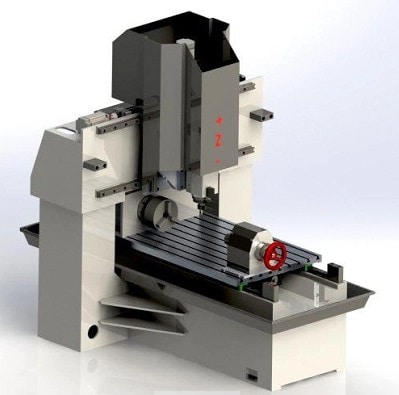
The structure of a 4-axis CNC machine includes several unique components:
- Chucks – Chucks, or Lathe Chucks, clamp the workpiece to the 4th axis when tombstones aren’t in use. They’re essential for tasks that require both milling and turning of a part. However, this setup limits you to working on one part at a time.
- Vise – The vise acts as a mounting surface for the workpiece, particularly in vertical 4-axis CNC machining. While directly clamping a workpiece allows only for top surface machining, vises enable access from three directions. Visually, vises can also be mounted on tombstones to increase the number of parts machined in a single run.
- Tombstone – Unlike in 3-axis CNC machining, the tombstone is a key feature in four-axis machines. It’s a tower-like structure with multiple attachment points for workpieces, similar to a milling table. In 4-axis machining, the tombstone can rotate, offering access to more surface areas and allowing for more parts to be worked on simultaneously. This feature is typically found in horizontal CNC machines but can also be present in vertical machines, although with limited clearance.
- Spindle Assembly – This is a variable-speed rotating spindle that holds the cutting tool, vital for the machining process.
- Cutting Tool – The cutting tool is responsible for removing material from the workpiece to shape the final product.
- Traveling Columns – These are the components that enable the movement of the spindle and cutting tool along the Z-axis (up and down) and X-axis (side to side).
- Index Table – This is the platform to which the workpiece or rotary index table is clamped, moving along the Y-axis. Some machining centers also rotate this table on a rotational B-axis.
- Rotary Index Table (optional 4th axis) – This mechanical device is used to hold and rotate the workpiece, referred to as the A-axis.
- CNC Control Panel – This interface is used by machinists to control the linear and rotational movements of the CNC machine’s operations.
The Process of 4-Axis CNC Machining
To grasp the workings of 4-axis CNC machining, one must understand the movements and capabilities of these CNC machines. They efficiently move the cutting tool along the X, Y, and Z axes, while also rotating the workpiece on the A axis. This additional axis enables the machine to manipulate the workpiece from various angles, allowing for the creation of complex and precise parts.
The 4-axis CNC machining process can be outlined in these steps:
- Programming: The programming for a 4-axis CNC machine is done using a CAM (Computer-Aided Manufacturing) program. This software creates an appropriate toolpath for the machine, detailing the sequence of machining, rotation speeds, and tool choices.
- Workholding: The workpiece is secured in the chuck of the 4th axis. In some cases, a tombstone is used on the 4th axis as a base to hold multiple parts. This setup enables the machining of several components simultaneously, eliminating the need for frequent recalibration.
- Machining: The actual machining process then starts. A 4-axis CNC machine is capable of performing both milling and turning operations. The machine follows the instructions provided by the CAM program.
- Finishing: After machining, any final touches like cleaning or deburring are carried out to complete the process.
Types of Projects Most Suitable for 4-Axis CNC Machining
Various projects are well-matched for 4-axis CNC machining:
Custom Part Fabrication
A frequent use of 4-axis CNC machining is in crafting bespoke parts or components for machines. This can range from making replacement parts to enhance efficiency or functionality to creating essential components for completing the assembly of an appliance. It’s also commonly used in 3D modeling and printing, developing prototypes or conceptual models, and producing personalized carvings, such as hobby signs.
Custom Tool and Die Fabrication
Another significant application is in the creation of custom tools or dies for specific uses or manufacturing processes. For instance, there might be a need to fabricate an unconventional tool or die for precise finishing of a part, like the underside of a gear. A 4-axis CNC machine can be set to work on one side of a part, then rotate it 90 degrees to machine the other side, all within the same setup.
Aerospace Industry
The aerospace sector frequently employs 4-axis CNC machining for various operations like turning, milling, and drilling. The high precision that 4-axis CNC machining offers is especially valuable for the production of the numerous small gears found in aircraft and spacecraft.
What are the Differences between 3, 4, and 5-Axis CNC Machining?
Differentiating between multi-axis CNC machining types is crucial for balancing factors like cost, product quality, and production time.
Accuracy and Precision
CNC machining is known for its high accuracy and tight tolerances. In 3-axis CNC machining, there’s a potential for errors due to frequent repositioning of the workpiece. While these errors are usually minor and acceptable for many applications, they can be problematic for precision-critical fields like aerospace.
In contrast, 4- and 5-axis machines don’t need as much repositioning, reducing the likelihood of errors. These machines can add features to a workpiece on multiple planes or positions using a single fixture, enhancing precision.
Machining Capability
The fundamental principle of CNC machining is the same across all types: a computer-controlled cutting tool moves around the material to make cuts, guided by G-Codes or M-Codes.
The key difference lies in the axes of rotation. Both 4- and 5-axis machines allow for rotation or movement along additional axes, facilitating the machining of products with complex shapes and geometries.
Costs
Cost is a major factor in choosing between 3-, 4-, and 5-axis machining. The 3-axis machine is usually the most cost-effective to purchase and maintain. However, the overall operating cost can be influenced by factors like the availability of skilled operators and fixtures.
On the other hand, 4- and 5-axis machines are more advanced and offer greater capabilities, making them more expensive. Despite their higher cost, their extensive capabilities make them suitable for specialized tasks.
How to Choose between 3, 4, and 5-axis CNC Machining?
The primary distinction among 3, 4, and 5-axis CNC machining lies in the level of axis movement between the cutting tool and the workpiece. The complexity of motion directly impacts the ability to produce parts with more complex geometries for various industries.
The number of axes a machine has indicates its milling process complexity, the intricacy it can achieve in milling a component, and the areas of the workpiece it can access. Moving from 3 to 4 to 5 axes, you progressively gain improved flexibility, features, and functionality.
The choice of machine depends on your specific manufacturing needs, the required intricacy and precision, and your budget. There’s no universal answer for everyone.
- 3-axis machines are ideal for lighter, high-speed machining tasks. They are well-suited for projects that produce small, simple parts and don’t require high precision. These machines allow for smaller cutter heads and minimize vibrations during machining.
- 4-axis machines are your go-to for creating complex 3D shapes, making holes and cut-outs around the sides of a workpiece or on cylindrical surfaces, and performing milling on angled surfaces of a component with high precision.
- 5-axis machines offer a highly efficient process for producing such intricate machined components if your project demands extreme precision and complex geometrical designs.
FAQs
Conclusion
The 4-axis CNC machine is a versatile and powerful tool suitable for various applications. To use it efficiently, it’s essential to understand both its strengths and shortcomings.
The decision between 5-axis, 4-axis, and 3-axis CNC machining hinges on the complexity of the part you need to machine and the level of precision required. For parts used in critical sectors like aerospace or medical, where sophisticated shapes and utmost precision are essential, 5-axis machining is the preferred choice. For creating special-shaped parts, such as those with cut-outs and holes around cylindrical structures or complex arcs like cam lobes and helixes, a 4-axis CNC machine is ideal. On the other hand, 3-axis machining is more suitable for simpler parts; it’s also more cost-effective and user-friendly.
Ultimately, the choice of which type relies heavily on the unique requirements of your project.
Multi-Axis CNC Machining Solution at Runsom Precision
For projects necessitating external manufacturing support, Runsom Precision stands out as an excellent choice for multi-axis CNC machining services. Equipped with advanced multi-axis machinery, we are well-prepared to meet diverse project demands.
Their team of specialists offers comprehensive guidance throughout your project, ensuring the delivery of high-quality, customized products. For project initiation, you can easily contact our team or request an instant online quote.
Other Articles You May Be Interested in:

